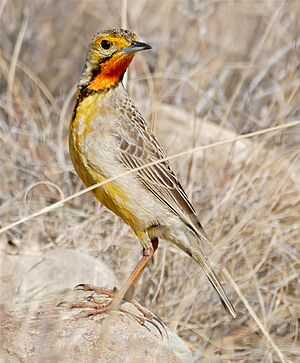Cape longclaw facts for kids
Quick facts for kids Cape longclaw |
|
|---|---|
 |
|
| Conservation status | |
| Scientific classification | |
| Genus: |
Macronyx
|
| Species: |
capensis
|
| Synonyms | |
|
Alauda capensis Linnaeus, 1766 |
|
The Cape longclaw is a beautiful bird found in southern Africa. It's also known as the orange-throated longclaw because of its bright orange throat. This bird is a type of passerine (perching bird) and belongs to the Motacillidae family. This family includes other birds like longclaws, pipits, and wagtails.
You can find Cape longclaws in countries like Zimbabwe and southern and eastern South Africa. They prefer living in grasslands, especially near water, like coastal areas or mountains.
About the Cape Longclaw's Name
Have you ever wondered how animals get their scientific names? For the Cape longclaw, it started a long time ago. In 1766, a famous Swedish scientist named Carl Linnaeus gave this bird its first scientific name, Alauda capensis.
The word capensis means "from the Cape." This refers to the Cape of Good Hope in South Africa, where the bird was first found. Later, in 1827, an English scientist named William Swainson placed the Cape longclaw in a new group, or genus, called Macronyx. This is why its full scientific name today is Macronyx capensis.
There are two main types, or subspecies, of Cape longclaws:
- M. c. capensis: Found in the southwest and south of South Africa.
- M. c. colletti: Found from southeast Botswana and Zimbabwe to Mozambique and eastern South Africa.
What Does a Cape Longclaw Look Like?
The Cape longclaw is about 19 to 20 centimeters (about 7.5 to 8 inches) long.
The adult male is quite striking. It has a grey head with a light stripe above its eye. Its back is streaked with blackish patterns. The most noticeable feature is its bright orange throat, which is why it's also called the orange-throated longclaw. It also has a black band across its chest and yellow feathers on its belly.
Female Cape longclaws are a bit duller than the males. They have a yellow throat instead of bright orange, and their chest band is not as strong. Young Cape longclaws (juveniles) have a yellowish throat, a faint chest band, and yellowish-white feathers underneath.
How Do Cape Longclaws Behave?
Cape longclaws usually live in pairs throughout the year. They spend their time on the ground, looking for food. Their diet mainly consists of insects, but they also eat some seeds.
These birds have a musical song that sounds like cheewit cheewit. When they want to communicate with each other, they make a tsweet sound. If they sense danger, they have a special alarm call that sounds like a soft meow.
You'll often see Cape longclaws standing tall on top of rocks, anthills, or large clumps of grass. When they do this, they stand very upright with their chest puffed out. This helps them look around for food or spot any danger.
It's interesting to note that the Cape longclaw looks a lot like meadowlarks, which are birds found in the Americas. Even though they are not related, they have developed similar looks because they live in similar grassland environments. This is called convergent evolution.


